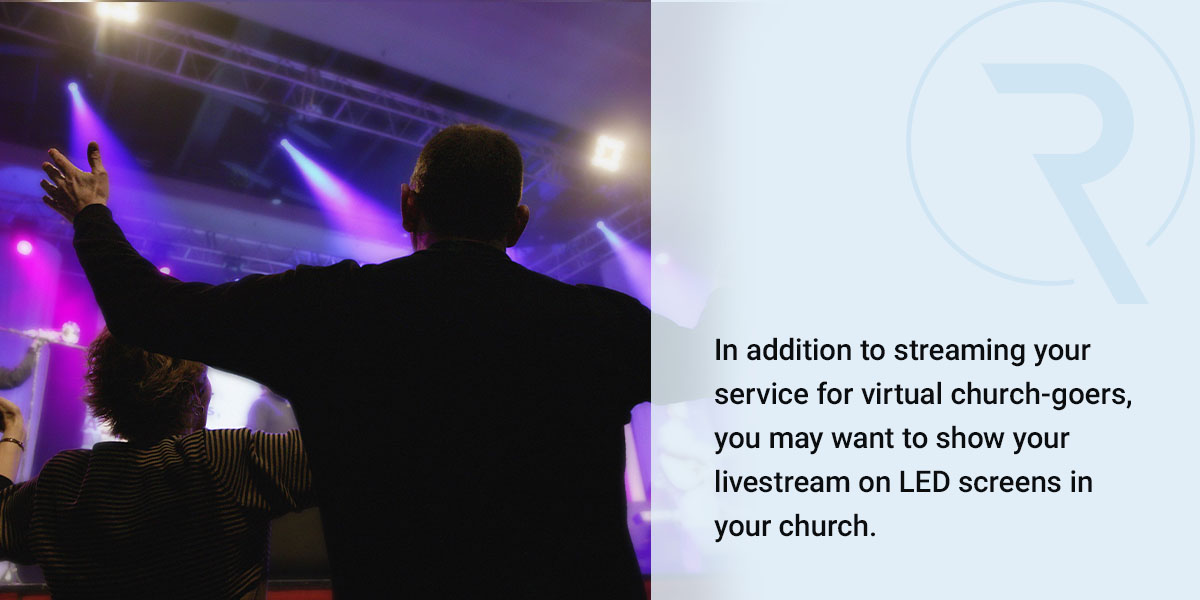How to Livestream Your Church Service
- Josh Dominguez
- Hits: 336
Livestreaming a church service or event has become more and more widespread. The pandemic had a big impact on in-person church attendance, and in 2022, 24% of American adults said they attended religious services online. In addition, 23% of Millennials and Gen-Xers say they read the Bible in a digital format, which speaks to the importance of going digital.
Today, more churches and ministries can utilize a range of livestreaming technologies that are reasonably priced, easy to use and offer seamless livestreaming capabilities, helping those at home share in your church service.
Why Livestream Your Church Service or Mass?
While attending church in person is still popular, livestreaming reaches and appeals to church-goers who may not otherwise attend an in-person service. Here are just a few reasons why church livestreaming is a good choice:
- Accessibility: Livestreaming makes your service accessible to anyone from anywhere with an internet connection.
- Community engagement: Going to church virtually helps foster a sense of community among those members who cannot attend and allows your congregants to stay connected even when physically apart.
- Outreach and growth: Church livestreaming provides an opportunity to reach new people, share your message and grow your community.
Equipment Needed to Livestream Your Service
What do you need to livestream your church service? Setting up a livestream is simple with the right tools. Here's a list of the equipment and components you will need:
- Cameras: The first item you will need is a high-quality camera that offers high-definition recording. This can be a webcam, a dedicated camcorder or a multipurpose DSLR camera. You will want one that performs in variable lighting conditions and includes an HDMI output to connect to your computer. You can also add more cameras to switch between angles during the service.
- Lighting: Although most cameras can adjust to different lighting conditions, dedicated lighting in addition to room lights can amplify the video image and quality.
- Tripod: Keep your camera stable and secure by mounting it on an adjustable tripod.
- Microphones: Your church likely has a selection of microphones used for in-person services. The trick is to make sure this audio goes through your audio mixer to transmit the sound during your church livestreaming.
- Audio mixer or interface: Your sound desk may already manage and mix audio during each service. You can connect one of the desk's audio output channels to an audio mixer or interface and then to your computer or streaming device. The audio mixer or interface will give you greater control of the audio going from the sound desk to your livestream.
- Video switcher: A switcher is optional, especially if you only have one camera. It allows you to switch your broadcast feed between multiple cameras and video signals.
- Computer or streaming device: You'll need a reliable computer or streaming device to handle the livestreaming process. It's a good idea to review the minimum recommended specifications for the streaming platform and software you use.
- Streaming software: If you only want to stream to a single social media channel like Facebook or YouTube, no additional software is required. Otherwise, you will need Restream, Streamlabs or OBS Studio for greater customization and to stream to multiple platforms simultaneously.
- Reliable internet connection: Stable, high-speed internet is crucial for church livestreaming. We recommend using a wired connection since an Ethernet cable tends to be more stable than Wi-Fi and can provide better speeds.
Steps to Livestream Your Service or Mass
Once you have the necessary equipment, take these steps to livestream your church services.
1. Set Up Video and Audio
Set up and connect all the physical equipment to ensure you have a feed running for viewers to watch. You will want to test this before your service to ensure there are no technical difficulties.
2. Select a Livestreaming Platform
Popular options that are easy to access include YouTube Live and Facebook Live. Additionally, you can set up your church's website so the livestream feed is embedded on a select page.
3. Set Up Your Streaming Software
You can install and configure your chosen streaming software and ensure your sound and video feeds are picking up. To connect your stream to your desired platforms, you will likely need to enter certain information into your streaming software, including your stream key and server settings. You can also begin queuing up different assets, such as song lyrics, graphics and presentations.
4. Test Your Setup
Conduct a test to ensure everything is connected and working smoothly as if it were a livestream. Check the video and audio quality and address any issues that might arise. You will also want to double-check any settings and features you will use during the church livestreaming.
5. Start Your Church Livestream
With everything in place, you can go live shortly before the service or mass begins. This timing will allow you to monitor the stream, start interacting with your virtual audience and resolve any issues before the service officially starts.
Final Tips
Before you embark on your church livestreaming journey, there are a few additional tips to help enhance your virtual church service experience and ensure everything goes smoothly.
Putting Your Livestream on Screens in Your Church

In addition to streaming your service for virtual church-goers, you may want to show your livestream on LED screens in your church. There are two primary ways you can achieve this.
The first option is to use an HDMI splitter and run the feed via long HDMI cables throughout the church to the different screens. The second option is much simpler. Ensure your screens have internet access, or you can connect a device, such as a laptop, to the screen using an HDMI cable, and use the church Wi-Fi to view the livestream that way.
Copyright, Licensing and Privacy
It's important to consider the type of music you play and the lyrics you display. Unless you write all your own music, you must acquire an official streaming license covering the worship music you intend to use.
Another factor to consider is the consent of individual members of your congregation who may appear in the camera frame. To account for this privacy concern, it's recommended to only show the stage during the livestream.
Projector Screens and Lighting
Your church likely has projector screens that display announcements, song lyrics and information before, during and after the service. Consider if these screens will be visible to both online viewers and in-person congregants during your livestreaming.
Projectors and projector screens only work in incredibly low-light conditions, which are not conducive for your cameras and virtual church-goers. Thankfully, installing LED walls is a quick, easy and versatile solution.
Invest in LED Walls From Refresh LED to Restore Your Sanctuary
Church livestreaming can have a widespread positive impact on your ministry and community. In addition to these upgrades, investing in LED walls for churches can boost your overall service experience and engagement. LED walls replace outdated projector screens and provide high-quality, crystal-clear imaging that performs under any lighting, whether harsh and bright or dim.
At Refresh LED, we live by Proverbs 11:25. As a faith-based company, our passionate team is always willing and able to assist churches in enhancing their ministries through technological improvements. During our unique process, we will walk with you from consultation to installation and beyond.
To start the process, submit our quote form or contact us today to talk about why LED walls are the right choice for your church.

















